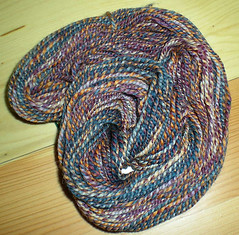By Amelia © July 7, 2008
A Lazy Kate is very handy for plying. Several wheels have built in kates, or come with kates to hold 2-3 bobbins. You can fashion your own lazy kate with knitting needles and a shoebox.
I own and use three kates, in addition to those on or with my wheels. My preference is for a tensioned lazy kate, so the bobbin doesn't over-run the plying and let the singles kink up before they reach my hand.
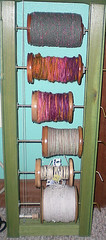
First, here's my Alexandra's Crafts bobbin tree – this is great because I put the tensioner on the bobbins I’m using and not the rest, and it “stores” six bobbins for me. This picture is of it folded against the wall, out of use. This kate mostly works with jumbo bobbins, but folded they may rub against each other, so I offset them when I fold it up. Bobbins are held horizontally, ensuring a side feed (very mandatory in plying, so you don’t wrap the post). I am now carrying these at The Bellwether,
contact me for availability.
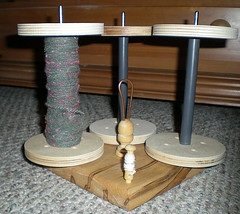
Second, is my Nancy’s Knit-Knacks
Katie-A-Go-Go – great for spindle-fulls (slid onto straws) and it holds big bobbins ~ Majacraft bobbins, SpinOlution bobbins, plying bobbins. Tensioned, too, with an orifice for ensuring a side-feed. Picture here holding the (really big!) bobbins from the SpinOlution Mach 1. I got mine, well, from me, to be quite straightforward. Nancy’s Knit Knacks also sells them directly, and many fibery places carry them – all her tools are solidly made and very functional. This can be taken apart and put into a small denim zipped sack, great for your spinner's basket.

Third, my Will Taylor JMM/Clever Kate, which has 3 pegs that are held at a 45-degree angle. This acts like a tension-string, without the string (woo-hoo!). I really enjoy this kate, as it’s great for putting thread bobbins on, too – on the Alexandra, thread bobbins tended to wrap the post (I haven’t tried thread bobbins on the NKK Kate). It also stores the pegs so it is almost flat when not in use. It’s great for plying with thread. I have had yarn wrap the post from bobbins once in a while, but if I make sure it’s side-feeding, that doesn’t happen. There are
two other shots of it in my flickr. Got it at
Carolina Homespun’s booth in the June NwRSA conference. A friend said she saw these and promptly put a door stopper under her Katie-A-Go-Go, to good effect. Yay! that means I now have 6 45-degree angle pegs, since I have one of those, too :-)
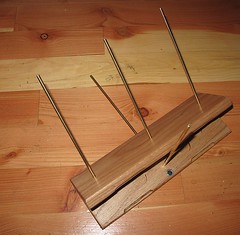
And in February, 2010, a new kate has arrived: the Ogle Designs Kate (on etsy). This is a folding-flat-for-storage kate that also fits 3 bobbins, holding them at an angle when open for use. A nice choice for those who want a flat package in their spinning tote, and a solid design for plying.
My take on kates is that it's good to look at a variety of kates (like wheels) and decide which features work for you or that you want.
The Nancy's Knit Knacks Kate has the plus that it all fits in a small package, fairly flat, and you get the zippered denim carry sack with it. That's cool because if you're a spindler, you can tuck a few straws in there as well.
The Will Taylor Clever Kate has the plus of the 45 degree rod angle and that it stores the rods on the base; it's not flat when stowed, though, as the 45 degree angle is accomplished with pieces of wood that add to the profile of the board.
The Ogle Designs Kate stows the rods in the board and also uses a hinge to get the angle, so it folds flat - a nice, clean design. It uses a rod along the floor to help keep it in place, and works nicely that way. There's a bit of a bounce on the hinge with heavy bobbins on the kate, so for pure useability, the Will Taylor would be my slight preference.
All three fit wide bobbins like Majacraft & Mach II, I forget if you can get 3 Ashford Bulkys on the NKK or not but you can get 3 Mach bobbins on it. And the one I didn't mention -- the Alexandra Crafts Horizontal -- is a different style; its plus is that it can be a bobbin storage solution as well, it's easy to tote with bobbins on it; but it doesn't become a single flat board like the other three.
Oh -- another difference to note is that the NKK is a neat little square that fits in pretty much any spare corner; the WT and Ogle are likely to "stick out" a bit, being a rectangular shape, 3-bobbins-in-a-row style vs. NKK's organizing them on a square.
In terms of history, the NKK came out first, then the WT CK, then the AC Horizontal, and most recently the Ogle Designs -- so clearly folks are trying to introduce improved products into the market, pondering what they can change to make a more effective kate while potentially losing features of the older ones.
Happy Kate shopping!
~~~
For related posts, see:
Why is my plying thread tangling? for a great thread management tip.
How can I control the bobbins on my non-tensioned lazy kate?
~~~
What's your favorite Lazy Kate? Let me know, I'm always looking for great tools!
~~~
© July 7, 2008 by Ask The Bellwether, posted at
http://askthebellwether.com/blog Updated 25 February 2010.
 Guess what! I'm going on vacation ... as posted on TheBellwether.com, I'll be out of town visiting our nation's capitol and my New Jersey in-laws, July 18-29. So orders made July 17-29 may not be seen until my return, and I'll be busy catching up on those and new orders until about August
Guess what! I'm going on vacation ... as posted on TheBellwether.com, I'll be out of town visiting our nation's capitol and my New Jersey in-laws, July 18-29. So orders made July 17-29 may not be seen until my return, and I'll be busy catching up on those and new orders until about August 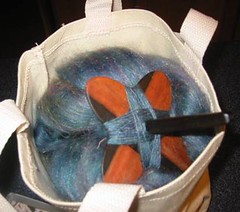 Please be patient as this is something I don't do too too often. It'll be a nice change, though you can rest assured that my traveling spindling is coming with me.
Please be patient as this is something I don't do too too often. It'll be a nice change, though you can rest assured that my traveling spindling is coming with me.




